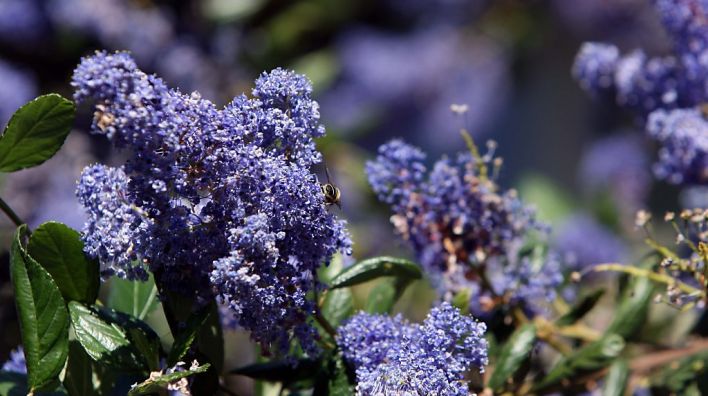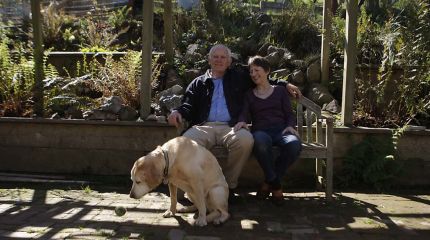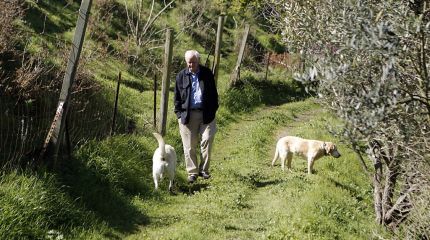| |
Bringing Back the Natives Garden Tour
More than 50 stops listed for annual tour in East Bay

Jessica Olthof, The Chronicle
The Butts' garden features natives, such as this huge ceanothus shrub.
Joe Eaton and Ron Sullivan
April 2, 2013
Formal or wild, lush or xeric, sprawling or pocket size, bayside or east of the Caldecott, professionally designed or do-it-yourself: Native plants can enhance any space. For proof, look no farther than two stops on this year's Bringing Back the Natives Garden Tour. Equal parts pleasure and inspiration, the May 5 showcase includes more than 50 gardens in Alameda and Contra Costa counties. Visitors must register by April 27.
Robert and Stephanie Sorenson's garden in the northeast corner of Orinda is new to the tour. Tom and Shirley Butt's garden in Point Richmond is making its fourth appearance. What the two have in common is space (much of it near vertical) and the integrity of a native plant community, preserved and discovered and full of surprises.
Two faces
The Sorensons' Orinda garden has two faces. The front garden, level with the street and house, replaced a formal lawn. Designed by David Bigham and planted by Anne Simpson, it now incarnates a meadow of native grasses, rushes, wild strawberries and other local flowers. A birdbath made from a 1 ton boulder focuses the eye and the action. It's all framed by a dry-laid stone wall in ancient Anatolian style and a disciplined big hedge of 'Little Gem' magnolia - a formal declaration of intent framing the loose, live flow of the meadow. Its habitat for birds and other wildlife delights Stephanie Sorenson, a birder and wildlife rescuer who once raised an opossum family.
Out back past the dressy patio, the lot drops vertiginously to Lauterwasser Creek and the wild takes over. Bigham calls this live-oak forest "a place where nature has us as a welcome guest."
When Sorenson began weeding here, he discovered a native understory including other trees (black and valley oaks, bigleaf maple, madrone), shrubs (toyon, gooseberry, coffeeberry), bulbs (blue dicks, Ithuriel's spear), grasses (California brome and fescue, blue wildrye) and ferns (coffee, sword, goldback) - 150 native species in all. "There's been a dialogue between me and Bob about how humans can help nature," said Bigham. "He had some incredible niches for specific plants. Having that suite of understory grasses survive is very unusual."
Sorenson has propagated the original cohort and added site-appropriate species from Native Here Nursery in Tilden Park. "I didn't know native plants when we moved here," he said. "I just liked the place, because I had grown up with a creek in my backyard. Then I realized I had a lot of natives. I started hand-pulling the weeds and putting back what I thought was here initially."
The place is a wildlife magnet. Stephanie Sorenson has logged 39 avian species, from bushtits to wild turkeys. Rustic bird boxes invite cavity nesters. The family has listed three amphibian, seven reptile and 10 mammal species; no mountain lions so far. They're just beginning to track their butterflies.
Undisturbed remnant
The 5-acre Butt property, uphill from the Richmond Natatorium, includes a rare undisturbed remnant of northern coastal prairie, mostly California fescue. Only 10 percent of this once extensive habitat still exists in the state. Here, the house is tucked into a niche well above street level and the natural space envelops it loosely, embracing and integrating the civilized space with the wild.
Tom Butt, an architect and Richmond City Council member, and his wife, Shirley, preserved the grassland and augmented it with other native plants. Since 1985, when they built the house and tackled the weeds, they've grown huge ceanothus shrubs and one of the largest holly-leaf cherry trees we've ever seen. Tangles of pipevine attract blue-black pipevine swallowtail butterflies, whose caterpillars feed on the leaves.

Jessica Olthof, The Chronicle
Tom and Shirley Butt's Point Richmond spread makes its fourth appearance on the Bringing Back the Natives Garden Tour.
Before native-plant nurseries existed, the Butts relied on the California Native Plant Society's annual sales. Now they shop at Richmond's Watershed Nursery. They've allowed select nonnatives like the white oak tree and lilac from Tom Butt's native Arkansas and two mysteriously volunteer cork oaks. "Everything's an experiment," he said. "It's all a big science project."
After five years of weeding, the native prairie requires minimal maintenance. The Butts' hoofed partners -four sheep and five goats - get moved seasonally to control broom, fennel, poison oak and other undesirables. They do eat the grass - but California bunchgrasses coevolved with grazing herds of elk and pronghorn.
Like the visiting wildlife and those bunchgrasses in the breeze, the art of native gardening flows, teaching and surprising us as we work and watch.
Bringing Back the Natives Garden Tour
Free, self-guided tour features 50 gardens throughout Alameda and Contra Costa counties. 10 a.m.-5 p.m. May 5. Includes plant sales with rare and hard-to-find natives. Registration is required. Early registration is advised. ww.bringingbackthenatives.net.
Joe Eaton and Ron Sullivan are naturalists and freelancers in Berkeley. E-mail: home@sfchronicle.com

Jessica Olthof, The Chronicle
Tom Butt walking with his dogs, Tess and Chispa, on his property on March 21st, 2013 in Point Richmond, Calif. Shirley and Tom Butt's garden at their home in Point Richmond is one of the stops on the Bringing Back the Natives Garden Tour.
Read more: http://www.sfchronicle.com/homeandgarden/article/Bringing-Back-the-Natives-Garden-Tour-4403583.php#ixzz2PPHw4C6U
|
|

